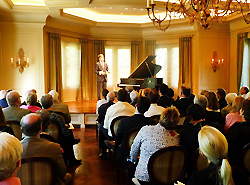
A dedicated concert hall built adjacent to a private home in North Dallas, TX has been outfitted with a sound reinforcement system headed by Tannoy loudspeakers driven by Lab.gruppen Contractor Series amplifiers.
Designed by David Marsh of Marsh/PMK International (formerly Pelton Marsh Kinsella), the system provides sound reinforcement for the roughly 125-seat venue using Tannoy CMS 601DC loudspeakers – each wired to a dedicated channel of a Lab.gruppen C 20:8x amplifier – and two Tannoy VSX 10BP subs powered by one Lab.gruppen C 10:4x.
Initially, the owner envisioned the space as a pure concert hall with no sound reinforcement system, Marsh says. “Holly Hall of HPD Architecture contacted me to ask if I’d do the acoustic design for the project, but the client was essentially the construction manager on the project and was emphatic that there would be no sound system.”
As the project progressed, however, in order to ensure the multi-purpose space met the needs of guest speakers, the classical, pop and jazz performers invited to perform there and the audience itself, the client realized some degree of sound reinforcement would be necessary – particularly for artists running background tracks. That said, the client stated: “My goal was that the audio infrastructure be concealed so the room would be very much a continuation of our house and could be used for both dinners and as a concert venue.”
Marsh worked closely with local integrators Dallas Sight and Sound on the design of the audio system and infrastructure; laying out the components necessary to provide intelligible sound reinforcement throughout the space without detracting from the aesthetic that Holly Hall envisioned.
“We provided a simple distributed system in the ceiling, which has coffers that vary in height between 14 and 15 feet,” Marsh notes. “We had to work the loudspeakers in around the coffers, sprinkler heads and lights including a large chandelier.”
The eight Tannoy CMS 601 DCs were wired direct to voice coil. Marsh continues: “Two were placed in the center of the ceiling area and three down each side.” Additionally, two Tannoy VSX 10 BT subwoofers were placed under the front of the stage, with the Lab.gruppen C10:4x amplifier driving the subs bridged to provide 500 watts to each of the subs.
“We’ve been using Tannoy for many years,” Marsh says, “about as long as they’ve been making ceiling speakers. What attracted us to Tannoy’s CMS line was their unique Dual Concentric design; they sound more consistent over a wider dispersion angle than anything else we’ve heard.”
He considered a number of subwoofers, but ultimately chose Tannoy’s VSX 10 BTs because of their low profile. “The stage isn’t that high, so we had to find something that would fit underneath it,” he says. “The VSX 10BTs are located in the middle of the stage front, side-by-side in a mirrored arrangement with the slot-shaped ports as close together as possible to achieve the greatest coupling effect. These subs in combination with the CMS ceiling speakers provide a warm and a highly musical sound quality.”
As for the choice of Lab.gruppen: “They’re one of the better amplifiers out there,” Marsh says. “They’re reliable and provide a lot of power in a small package, which was ideal in this case because we didn’t have much rack space to work with.”
Other system elements include multiple playback sources, BSS BLU-100 DSP, a Yamaha LS9-16 digital console, a Shure ULXD 24 wireless system and a compliment of portable gear.
Aesthetics, room acoustics, isolation from outdoor sound and mitigation of HVAC noise all had a substantial impact on Hall’s architectural design. ”Acoustical glass” and heavily sealed glass doors were used to isolate the room from outdoor noise, such as a nearby mechanical yard that includes an emergency generator and 65-ton chiller. Sound diffusing treatments were installed on the side walls and on the rear wall.
Additionally, decorative beams created the coffered ceiling that helps to break up and scatter useful overhead reflections. “I’ve done this kind of work in commercial settings before,” Hall says, “but never in a residence. The walls and acoustic treatments are covered in fabric. We looked at two or three hundred fabrics with the interior designer, John Marrs, to find something that worked acoustically while retaining the residential character of the space. The acoustics affected every single bit of the design.”
Additionally, Marsh recommended an acoustic enhancement system that was to electronically simulate reverberation and create laterally arriving sound to increase perception of aural spaciousness that is typically lacking in a room of this size. The system, which Marsh likes to refer to as “electronic architecture,” used the Tannoy ceiling loudspeakers already in the design along with small boundary-type microphones hidden in the ceiling and special signal processing. Although the components were selected and the conduit was installed, the owner has (so far) decided not to install the acoustic enhancement system because she is so impressed with the natural acoustics of the room.
“It was an unusual project,” Marsh sums up, “and to do it properly took a considerable amount of vigor and commitment on the part of the client.”
“In the end, Hall adds, “the clients are thrilled.”
